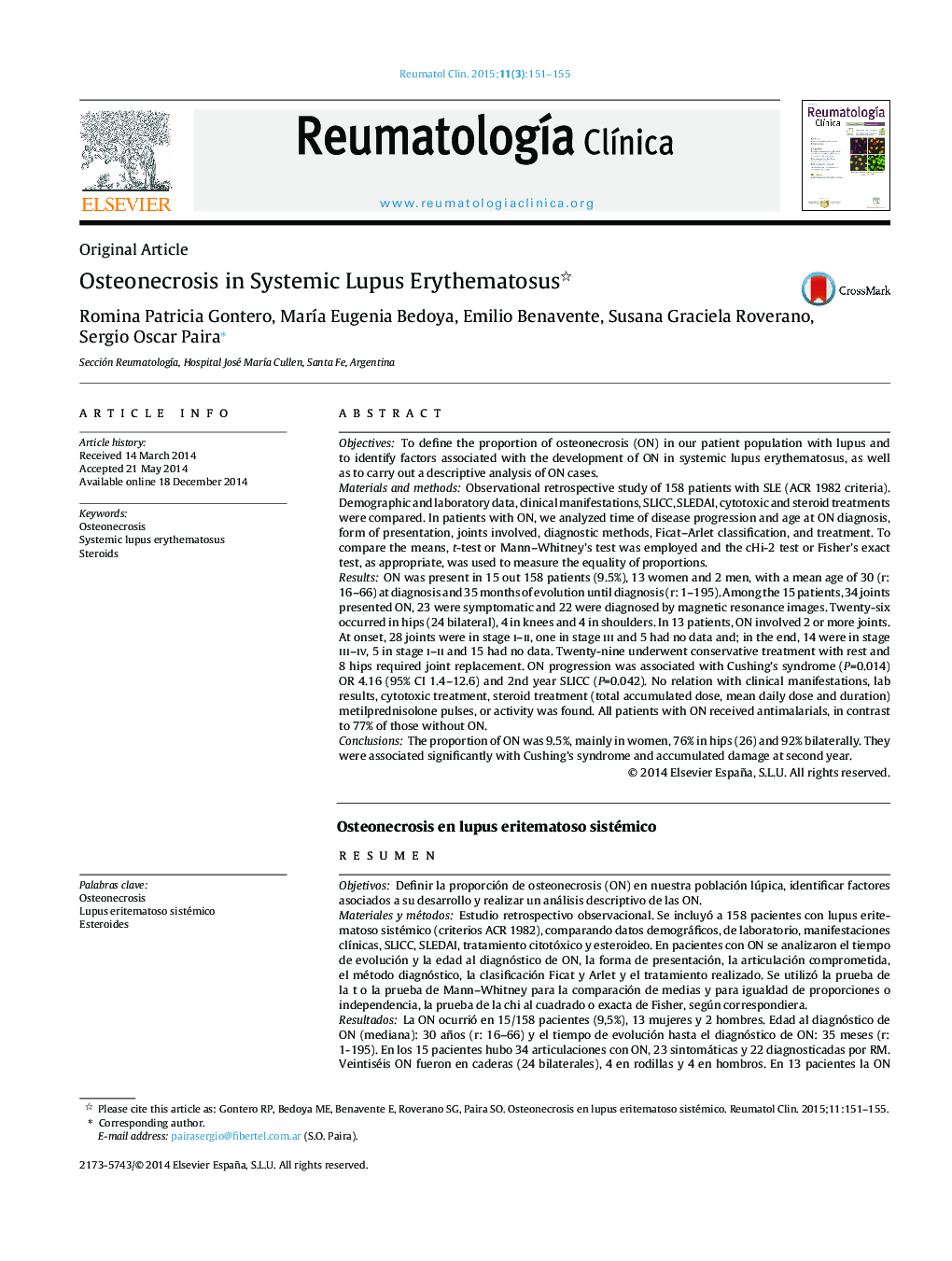| Article ID | Journal | Published Year | Pages | File Type |
|---|---|---|---|---|
| 3384100 | Reumatología Clínica (English Edition) | 2015 | 5 Pages |
ObjectivesTo define the proportion of osteonecrosis (ON) in our patient population with lupus and to identify factors associated with the development of ON in systemic lupus erythematosus, as well as to carry out a descriptive analysis of ON cases.Materials and methodsObservational retrospective study of 158 patients with SLE (ACR 1982 criteria). Demographic and laboratory data, clinical manifestations, SLICC, SLEDAI, cytotoxic and steroid treatments were compared. In patients with ON, we analyzed time of disease progression and age at ON diagnosis, form of presentation, joints involved, diagnostic methods, Ficat–Arlet classification, and treatment. To compare the means, t-test or Mann–Whitney's test was employed and the cHi-2 test or Fisher's exact test, as appropriate, was used to measure the equality of proportions.ResultsON was present in 15 out 158 patients (9.5%), 13 women and 2 men, with a mean age of 30 (r: 16–66) at diagnosis and 35 months of evolution until diagnosis (r: 1–195). Among the 15 patients, 34 joints presented ON, 23 were symptomatic and 22 were diagnosed by magnetic resonance images. Twenty-six occurred in hips (24 bilateral), 4 in knees and 4 in shoulders. In 13 patients, ON involved 2 or more joints. At onset, 28 joints were in stage i–ii, one in stage iii and 5 had no data and; in the end, 14 were in stage iii–iv, 5 in stage i–ii and 15 had no data. Twenty-nine underwent conservative treatment with rest and 8 hips required joint replacement. ON progression was associated with Cushing's syndrome (P=0.014) OR 4.16 (95% CI 1.4–12.6) and 2nd year SLICC (P=0.042). No relation with clinical manifestations, lab results, cytotoxic treatment, steroid treatment (total accumulated dose, mean daily dose and duration) metilprednisolone pulses, or activity was found. All patients with ON received antimalarials, in contrast to 77% of those without ON.ConclusionsThe proportion of ON was 9.5%, mainly in women, 76% in hips (26) and 92% bilaterally. They were associated significantly with Cushing's syndrome and accumulated damage at second year.
ResumenObjetivosDefinir la proporción de osteonecrosis (ON) en nuestra población lúpica, identificar factores asociados a su desarrollo y realizar un análisis descriptivo de las ON.Materiales y métodosEstudio retrospectivo observacional. Se incluyó a 158 pacientes con lupus eritematoso sistémico (criterios ACR 1982), comparando datos demográficos, de laboratorio, manifestaciones clínicas, SLICC, SLEDAI, tratamiento citotóxico y esteroideo. En pacientes con ON se analizaron el tiempo de evolución y la edad al diagnóstico de ON, la forma de presentación, la articulación comprometida, el método diagnóstico, la clasificación Ficat y Arlet y el tratamiento realizado. Se utilizó la prueba de la t o la prueba de Mann–Whitney para la comparación de medias y para igualdad de proporciones o independencia, la prueba de la chi al cuadrado o exacta de Fisher, según correspondiera.ResultadosLa ON ocurrió en 15/158 pacientes (9,5%), 13 mujeres y 2 hombres. Edad al diagnóstico de ON (mediana): 30 años (r: 16–66) y el tiempo de evolución hasta el diagnóstico de ON: 35 meses (r: 1-195). En los 15 pacientes hubo 34 articulaciones con ON, 23 sintomáticas y 22 diagnosticadas por RM. Veintiséis ON fueron en caderas (24 bilaterales), 4 en rodillas y 4 en hombros. En 13 pacientes la ON afectó a 2 o más articulaciones. Al inicio, 28 articulaciones estaban en estadio i-ii, uno en estadio iii y 5 sin datos y al final, 14 en estadio iii-iv, 5 en estadio i-ii y 15 sin datos. Veintinueve se trataron con reposo y 8 caderas requirieron reemplazo articular. La ON se asoció a aspecto Cushing (p = 0,014), OR 4,16 (IC 95% 1,4-12,6) y SLICC 2.° año (p = 0,042). No hubo relación con manifestaciones clínicas, datos de laboratorio, tratamiento citotóxico o dosis de esteroides ni actividad. Todos los pacientes con ON recibieron antipalúdicos, a diferencia de un 77% de aquellos sin ON.ConclusionesLa proporción de ON fue del 9,5%, la mayoría fue en mujeres, el 76% en caderas (26) y el 92% bilateral. Se asociaron significativamente a aspecto Cushing y daño acumulado al segundo año. No se halló relación con el resto de las variables evaluadas.
